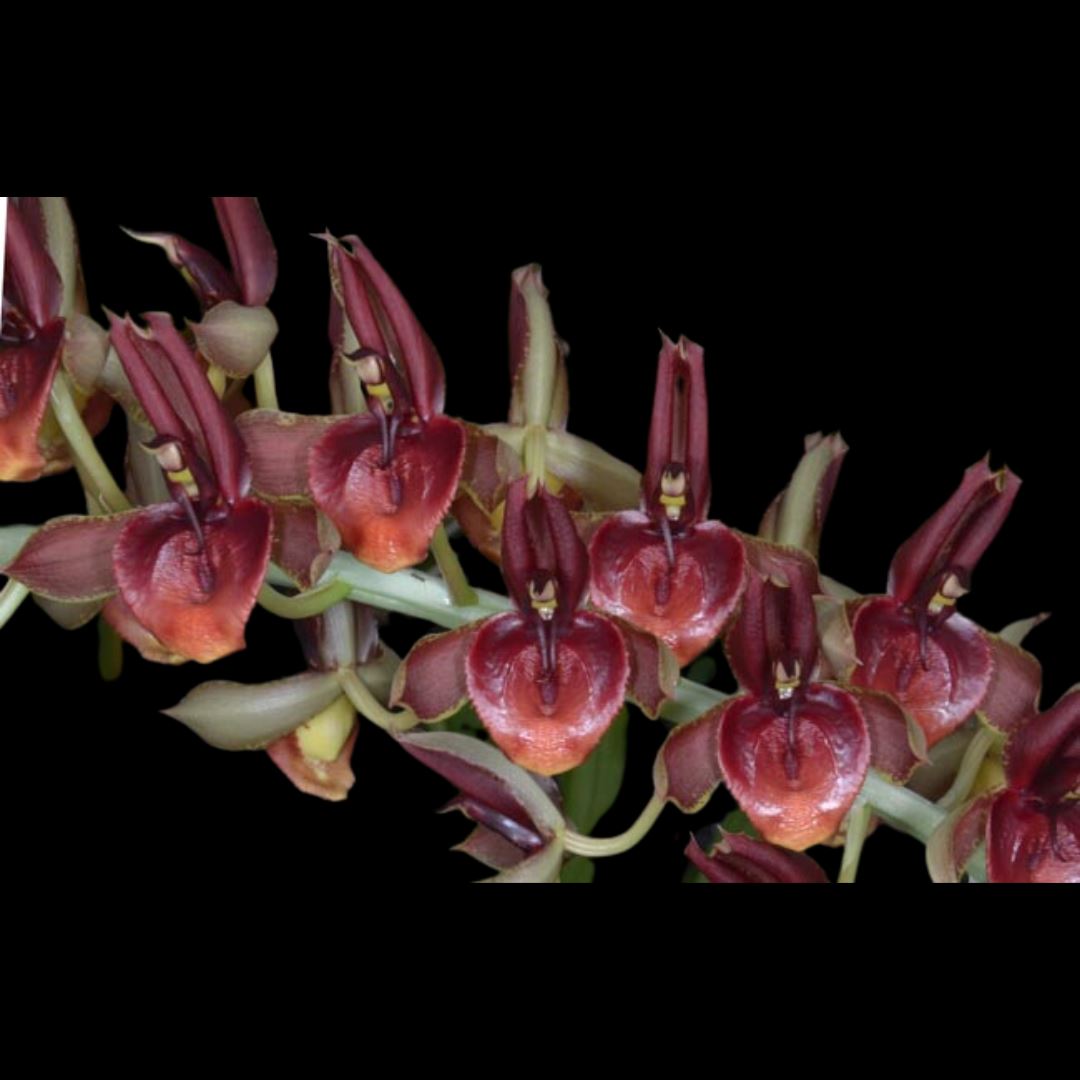La Foresta Orchids
Catasetum spitzii var. Red
Catasetum spitzii var. Red
No se pudo cargar la disponibilidad de retiro
Introducing the Catasetum spitzii var. Red, a very rare and hard to find catasetum, a remarkable orchid species endemic to the Brazilian state of Goiás on the central plateau. Thriving in the open savannah at elevations of up to 800 meters, this exquisite orchid displays a unique beauty deeply intertwined with its natural habitat. It commonly finds its host trees among various palms, the souari nut tree, the senna tree, the lixeira, and the typical savannah trees like Tabebuia caraiba and Guajacum sanctum, characterized by their rugged, corklike bark.
This medium-sized epiphyte exhibits a penchant for hot to warm climates. Its short, fusiform pseudobulbs can reach up to 12 cm in length and 5.5 cm in width, supporting numerous plicate, narrowly elliptic leaves that can extend up to 38 cm in length and 8 cm in width.
In the fall, the Spitz's Catasetum adorns itself with splendid blooms, emerging from a newly developing pseudobulb. The inflorescence is basal, measuring about 40 cm in length, and carries an array of flowers, varying in both color and size. The male flowers, at their natural position, measure 58 x 52 mm and exhibit sepals and petals in a red hue, a lip ranging from pale red to pink, and a deep yellow conical callus. The column retains its pale green shade, while the lip's inner surface and both sides of the column glisten. Meanwhile, the female flowers measure 55 x 27 mm, with red coloring and darker striations inside the lip sac, as well as almond red peduncles and pedicels.
Key features for identifying this species include the male flowers' more convex lip form, distinct from the pouch-shaped variety, with a subtle trough-like depression beneath the thick callus at the base of the disc. The midlobe boasts a thick, rounded apex, with cilia on the margins of the lateral lobes, and the pseudobulbs tend to be unusually short and plump. Varieties include var. album (featuring green-white sepals and petals with a white lip, occasionally tinged with yellowish hues in the callus area), var. roseum (known for its rose-colored flowers, particularly vivid on the lip), and var. sanguineum (distinguished by its blood-red lip).
Cultivating the Catasetum spitzii var. Red requires attention to several essential factors:
Light: These sun-loving plants thrive under a light level of 30,000-60,000 lux. To mimic their natural habitat, provide some shade (40-60% shade) unless strong air movement is available. It's also possible to grow them under artificial lights if sufficient intensity is ensured, and during the summer, they can be moved outdoors if their moisture needs are met.
Temperature: Originating from a continental climate, these orchids endure long dry seasons and low humidity throughout much of the year. Days are hot and dry, while nights tend to be cooler. In cultivation, maintaining a minimum night temperature of 18°C is recommended.
Humidity: For optimal growth and flowering, maintain humidity levels at around 70%, although these orchids can tolerate 40-60% humidity during their growing season.
Potting and Repotting: It's best to grow Catasetum spitzii var. Red in a suspended pot or basket filled with wood and bark chunks due to its nearly horizontal inflorescence. Repot annually, never waiting more than two years. Ideal timing for potting or repotting is when new growth reaches approximately 5 cm in height, and the nubs have developed into new roots reaching for support.
Watering: These orchids receive frequent rainfall even during dormancy in their natural habitat. In cultivation, water them on sunny days during the growing season, ensuring they dry relatively quickly. Allow the plant to slightly dry out between waterings.
Fertilizer: Apply an appropriate formulation weekly during the growing season or use a weak formula every time you water. Start with a high-nitrogen fertilizer (e.g., 10-5-5) containing trace elements. As leaves unfurl and before flowering, introduce a high-phosphorus formula to promote robust pseudobulbs capable of producing strong inflorescences. Soluble products with a significant second-digit number (e.g., 3-12-6) are suitable sources of phosphorus.
Rest Period: Respect the long rest period, resembling the protracted dry season in their natural habitat. Reduce watering frequency during dormancy, and stop fertilization entirely during this period. In the spring, when the growth cycle begins, ensure water is not readily available to the newly developing roots until they reach a height of at least 5 cm.
This is a near blooming size in a 4" pot about 2 to 3 years to bloom, grown from seed, limited!
Incorporating these cultivation tips and appreciating the unique beauty of the Catasetum spitzii var. Red, you can nurture this exquisite orchid to thrive and display its mesmerizing blooms, reminiscent of its native Brazilian savannah habitat.










